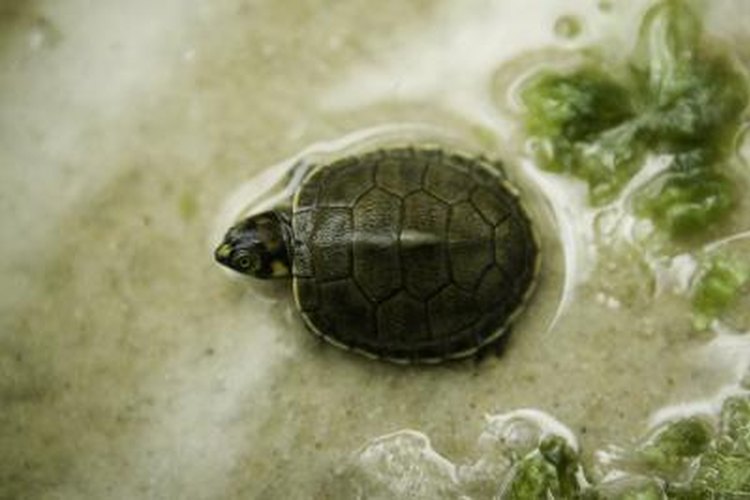To keep your turtle tank from smelling, clean the tank regularly and ensure proper filtration. Remove uneaten food and waste promptly.
Maintaining a fresh and odor-free turtle tank is essential for your pet’s health and your home’s comfort. Regular cleaning helps prevent the build-up of harmful bacteria and algae that can cause unpleasant smells. A good filtration system is crucial for circulating water and keeping it clean.
Feed your turtle in a separate container to reduce food debris in the tank. Regular water changes and tank maintenance create a healthier environment for your turtle. By following these simple steps, you can enjoy a clean and fresh-smelling turtle tank.

Introduction To Turtle Tank Odor Issues
Keeping a turtle tank clean and odor-free is essential. A smelly tank is not only unpleasant but also harmful to your turtle. Understanding the reasons behind the odor and maintaining a clean habitat will ensure your turtle’s health and happiness.
Common Reasons For Smelly Turtle Tanks
Several factors can cause your turtle tank to smell. Here are the most common reasons:
- Dirty water: Waste and uneaten food pollute the water.
- Improper filtration: A weak filter can’t clean the water properly.
- Overfeeding: Excess food rots and causes bad odors.
- Neglected tank maintenance: Lack of regular cleaning leads to build-up of waste.
- Inadequate tank size: Small tanks get dirty quicker.
Why A Clean Habitat Is Crucial For Turtle Health
A clean tank is vital for your turtle’s health. Here are the main reasons:
| Reason | Explanation |
|---|---|
| Prevents disease | Clean water reduces the risk of infections. |
| Improves quality of life | A clean tank provides a comfortable environment. |
| Reduces stress | A healthy habitat keeps your turtle calm and happy. |
| Promotes longevity | Healthy turtles live longer in clean conditions. |
Regular cleaning and proper care will keep your turtle tank smelling fresh. Your turtle will thrive in a clean and healthy environment.
Regular Cleaning Routines
Keeping your turtle tank clean is essential for a fresh-smelling environment. Regular cleaning routines help maintain water quality and prevent foul odors. Follow these simple steps to keep your turtle tank in top condition.
Frequency Of Tank Cleaning
How often should you clean your turtle tank? This depends on the size of the tank and the number of turtles. For a small tank, clean it every week. For a larger tank, clean it every two weeks. If you have more turtles, you might need to clean more often.
Step-by-step Guide To Cleaning Your Turtle Tank
- Gather your supplies: You will need a bucket, a siphon, a scrub brush, and water conditioner.
- Remove the turtle: Place your turtle in a safe, temporary container with some water.
- Drain the water: Use the siphon to remove at least half of the tank water.
- Clean the tank walls: Use the scrub brush to remove any algae or dirt from the tank walls.
- Rinse decorations and filter: Remove and rinse any tank decorations and the filter media in old tank water.
- Refill the tank: Add fresh, dechlorinated water back into the tank. Use water conditioner to remove chlorine.
- Check the temperature: Ensure the water temperature is suitable for your turtle before placing it back.
- Return the turtle: Gently place your turtle back into the clean tank.
Following these steps ensures your turtle tank stays clean and odor-free. Regular cleaning routines keep your turtle happy and healthy.
Proper Filtration Systems
Keeping your turtle tank clean and odor-free requires a good filtration system. A proper filter not only keeps the water clear but also removes harmful substances. Let’s explore how to choose the right filter and maintain it for optimal performance.
Choosing The Right Filter For Your Tank
Choosing the right filter is essential. The size of your tank matters. For a small tank, an internal filter works well. For larger tanks, consider a canister filter. It handles more waste and keeps the water cleaner.
Check the filter’s flow rate. It should turn over the tank’s volume 3-4 times per hour. For a 20-gallon tank, look for a filter with a flow rate of 60-80 gallons per hour (GPH). A filter with mechanical, chemical, and biological filtration is ideal. This combination removes debris, toxins, and harmful bacteria.
Maintenance Tips For Optimal Filter Performance
Regular maintenance is key to keeping your filter working well. Clean the filter media every month. Rinse it with tank water, not tap water. Tap water contains chlorine, which kills beneficial bacteria. Replace the chemical media, like activated carbon, every 4-6 weeks. This ensures it continues to remove toxins effectively.
Check the filter’s impeller and tubing for debris. Clean them if needed. This prevents clogs and maintains water flow. Inspect the filter’s seals and gaskets. Replace them if worn out to prevent leaks.
| Maintenance Task | Frequency |
|---|---|
| Clean filter media | Monthly |
| Replace chemical media | Every 4-6 weeks |
| Inspect impeller and tubing | Monthly |
| Check seals and gaskets | Every 3 months |
Following these tips ensures your turtle tank stays clean and fresh. A well-maintained filter is your best ally in preventing odors. Happy turtle keeping!

Water Quality Management
Keeping your turtle tank from smelling involves effective water quality management. Clean water is essential for your turtle’s health. It also prevents unpleasant odors. The following sections explain key steps to maintain water quality.
Testing And Adjusting Water Parameters
Regularly test your tank’s water parameters. Use a water testing kit. Check for ammonia, nitrite, and nitrate levels. High levels can cause bad smells. You should also measure pH levels. Turtles need a pH between 6.5 and 8.0.
Adjust water parameters if needed. Use water conditioners to control ammonia and nitrite levels. You can also add pH adjusters. Keep a record of your test results. This helps track water quality over time.
Changing Water To Prevent Odor Buildup
Change a portion of the tank water weekly. Replace 25% to 50% of the water. This helps remove waste and toxins.
Use a gravel vacuum to clean the tank bottom. It removes debris and leftover food. Always treat tap water before adding it to the tank. Use a dechlorinator to make the water safe for turtles.
| Water Quality Tasks | Frequency |
|---|---|
| Test Water Parameters | Weekly |
| Change Water | Weekly |
| Gravel Vacuuming | Weekly |
Consistent water quality management keeps your turtle healthy. It also keeps the tank smelling fresh.
Controlling Algae Growth
Keeping your turtle tank from smelling can be challenging. One major culprit is algae growth. Algae can quickly take over your tank, leading to foul odors. By controlling algae growth, you can maintain a clean and fresh-smelling tank. This section will cover natural solutions and safe chemical treatments to manage algae.
Natural Solutions For Algae Control
There are several natural ways to control algae in your turtle tank. These methods are safe for your turtles and the environment.
- Reduce Light Exposure: Algae need light to grow. Limit the amount of light your tank receives. Use a timer to control the light duration.
- Introduce Algae-Eating Fish: Some fish species, like plecos and snails, eat algae. Adding them to your tank can help control algae naturally.
- Regular Water Changes: Replace a portion of the tank water weekly. This helps remove excess nutrients that algae feed on.
- Use Live Plants: Live plants compete with algae for nutrients. Adding them to your tank can reduce algae growth.
Safe Chemical Treatments For Persistent Algae Issues
Sometimes, natural methods may not be enough. Safe chemical treatments can help control stubborn algae.
| Product | Usage | Effectiveness |
|---|---|---|
| AlgaeFix | Weekly | High |
| API Algaecide | As needed | Moderate |
| Seachem Flourish Excel | Daily | High |
Follow the instructions on the product label carefully. Overusing chemicals can harm your turtles. Always monitor your tank after treatment to ensure your turtles are safe.
Turtle Diet And Waste Handling
Maintaining a clean turtle tank can be challenging. An essential aspect is managing the turtle’s diet and waste. Proper feeding and waste handling can significantly reduce tank odor.
Feeding Practices To Reduce Waste
Feeding your turtle properly can help minimize waste. Here are some tips:
- Feed the right amount: Overfeeding leads to excess waste. Follow the recommended portion sizes for your turtle’s species.
- Use a separate feeding tank: Feeding your turtle in a different tank can reduce leftover food in the main tank.
- Choose high-quality food: High-quality turtle food is more digestible, resulting in less waste.
- Include fresh vegetables: Vegetables are less likely to decay quickly, reducing bad smells.
Managing Turtle Feces And Leftover Food
Proper waste management is crucial for a clean tank. Here are some strategies:
- Remove waste daily: Use a net to scoop out feces and leftover food every day.
- Install a good filter: A high-quality filter helps remove waste particles from the water.
- Perform regular water changes: Change a portion of the water weekly to keep it fresh.
- Use a substrate cleaner: A substrate cleaner can help remove debris from the bottom of the tank.
Implementing these practices will help keep your turtle tank odor-free and healthy.
Tank Accessories And Substrate Choices
Maintaining a clean and fresh-smelling turtle tank can be challenging. The key lies in choosing the right tank accessories and substrate choices. These elements play a crucial role in controlling odors and ensuring a healthy environment for your turtle.
Selecting The Right Substrate For Easy Cleaning
Choosing the right substrate makes cleaning easier and keeps odors at bay. Here are some popular substrate options:
- Gravel: Easy to clean but can trap waste.
- Sand: Natural look but needs regular stirring.
- Large River Rocks: Prevents waste buildup but harder to clean.
Gravel and sand are common choices, but they require regular maintenance. Large river rocks are a great alternative, preventing waste from getting trapped.
Decorations And Plants That Help Reduce Odors
The right decorations and plants can significantly reduce tank odors. Consider these options:
- Live Plants: Absorb waste and provide oxygen.
- Artificial Plants: Easier to clean and maintain.
- Hiding Spots: Create a natural habitat for your turtle.
Live plants like Anubias and Java Fern are excellent choices. They help in absorbing waste and provide oxygen. Artificial plants are easier to clean and still offer a natural look.
Adding hiding spots like caves or logs can also help. They make your turtle feel secure and reduce stress, which can decrease waste production.
| Accessory | Benefit |
|---|---|
| Gravel | Easy to clean |
| Sand | Natural look |
| Large River Rocks | Prevents waste buildup |
| Live Plants | Absorb waste, provide oxygen |
| Artificial Plants | Easy to clean |
| Hiding Spots | Reduce stress |
Choose the right substrate and accessories to keep your turtle tank smelling fresh.

Addressing Turtle Health Concerns
Keeping a turtle tank clean requires more than just water changes. Your turtle’s health is key to a fresh-smelling tank. Addressing health concerns ensures your turtle and its habitat stay healthy.
Identifying Health Issues That Cause Odors
Turtles can have health problems that cause bad smells. Identifying these issues is crucial. Here are some common signs:
- Shell Rot: Look for soft spots or foul-smelling discharge on the shell.
- Skin Infections: Watch for red, swollen, or peeling skin.
- Respiratory Infections: Listen for wheezing or see mucus around the nose.
- Parasites: Check for unusual spots or behavior changes.
Preventive Care To Keep Your Turtle And Tank Fresh
Regular care keeps your turtle and tank in good condition. Follow these preventive steps:
| Preventive Measure | Details |
|---|---|
| Regular Cleaning | Clean the tank weekly. Replace 25% of the water. |
| Healthy Diet | Feed a balanced diet. Avoid overfeeding. |
| Proper Filtration | Use a strong filter to remove waste and debris. |
| UVB Lighting | Provide UVB light to boost the turtle’s health. |
| Regular Vet Checkups | Take your turtle for checkups twice a year. |
Following these tips helps keep your turtle tank fresh. A healthy turtle means a clean tank.
Innovative Solutions To Odor Problems
Keeping a turtle tank smelling fresh can be a challenge. But innovative solutions can help you tackle this problem effectively. Below, we explore natural remedies and the latest products designed for turtle tank odor management.
Natural Remedies For A Fresh-smelling Tank
Natural remedies are often the best choice. They are safe for turtles and environmentally friendly.
- Baking Soda: Sprinkle a small amount on the tank floor.
- Activated Charcoal: Place it in the filter to absorb odors.
- Vinegar: Use diluted vinegar to clean tank surfaces.
- Live Plants: Add aquatic plants to improve water quality.
These simple solutions help keep the tank smelling fresh without harmful chemicals.
Latest Products In Turtle Tank Odor Management
New products can make a big difference in managing turtle tank odors. Here are some of the latest:
| Product | Description | Benefits |
|---|---|---|
| Odor Control Filters | Special filters designed to trap and neutralize odors. | Easy to install and maintain. |
| Enzyme Cleaners | Breaks down organic waste to reduce smells. | Safe for turtles and effective. |
| Water Conditioners | Neutralizes harmful substances and bad smells. | Improves water quality and odor. |
These products are designed to make turtle tank maintenance easier and more effective.
Conclusion: Enjoying A Fresh Turtle Habitat
Maintaining a fresh turtle tank is vital for your pet’s health. A clean tank also ensures your home remains odor-free. By following simple steps, you can create a pleasant environment for your turtle.
Summarizing Key Strategies For Odor Prevention
To keep your turtle tank from smelling, consider the following strategies:
- Regular Water Changes: Replace a portion of the water weekly.
- Effective Filtration: Use a high-quality filter to remove waste.
- Proper Tank Size: Ensure the tank is large enough for your turtle.
- Cleaning Schedule: Clean the tank and decorations regularly.
- Feeding Practices: Avoid overfeeding and remove uneaten food promptly.
- Substrate Choice: Use easy-to-clean substrates like river rocks.
- Adequate Aeration: Ensure good water circulation to prevent stagnation.
Long-term Benefits Of A Clean Turtle Environment
Maintaining a clean turtle tank offers several long-term benefits:
- Healthier Turtles: Reduced risk of diseases and infections.
- Better Water Quality: Clear water that promotes turtle well-being.
- Odor-Free Home: A pleasant environment for you and your family.
- Longer Filter Life: Less frequent need for filter replacements.
- Enhanced Viewing Pleasure: Enjoy watching your turtle in a pristine habitat.
By implementing these strategies, you will enjoy a fresh turtle habitat. This ensures a happy and healthy pet.
Frequently Asked Questions
Why Does My Turtle Tank Stink So Bad?
A stinky turtle tank often means dirty water, excess food, or waste buildup. Clean the tank regularly to prevent odor.
What Can I Put In My Turtle Tank To Keep It Clean?
Use a good water filter, UV sterilizer, and add live plants. Clean the tank regularly.
Can I Put Baking Soda In My Turtle Tank?
Yes, you can use baking soda in a turtle tank to raise pH levels. Use it sparingly to avoid drastic changes.
Can I Put Bleach In My Turtle Tank?
No, do not put bleach in your turtle tank. It can harm your turtle and damage the tank’s environment.
Conclusion
Maintaining a fresh turtle tank is crucial for your pet’s health. Regular cleaning and proper filtration help immensely. Ensure you feed your turtle correctly and remove uneaten food promptly. Invest in a good water conditioner. A clean tank keeps your turtle happy and your home odor-free.





Leave a Reply